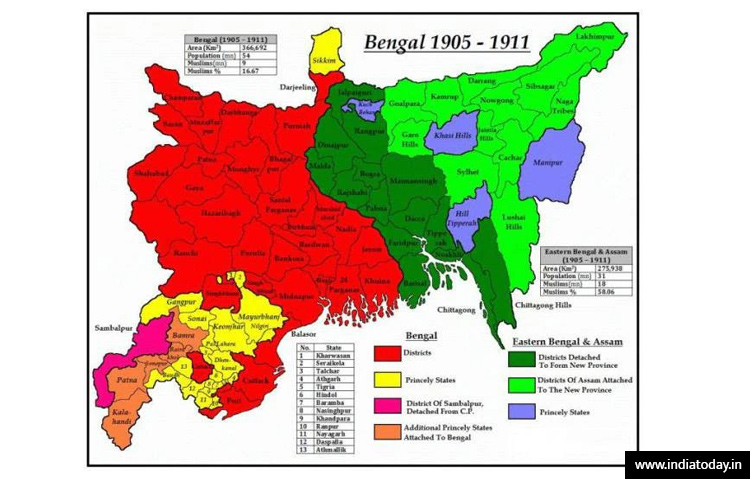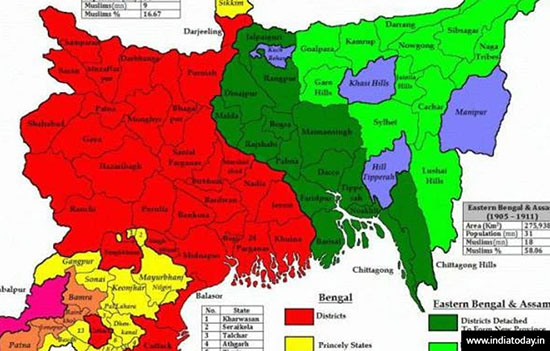- FAQ covers why was the scheme for partition of Bengal envisaged? What were the reasons behind decision to Partition Bengal and why was the Partition Plan reversed and its Impact on Assam? The learnings are relevant today.
Repeatedly the Congress/TMC and BJP exchange barbs on the partition of Bengal that took place in 1905. What happened then? When looking for answers, I refer to my go to volumes, The History and Culture of Indian People published by the Bharatiya Vidya Bhavan.
For this compilation I referred to
Volume 11 titled Struggle for Freedom
whose first edition was published in 1969 and second in 1988. All credits to
authors. Copyright Bhavan-Ch 2 & Ch 7. Some matter taken verbatim from
book.
1. What was the area
covered by Bengal in 1905?
Since the constitution in 1874, of Assam
as a separate province with the three Bengali-speaking districts of Goalpara,
Cachar and Sylhet attached to it, the
province consisted of Bengal proper Bihar, Orissa and Chota Nagpur (for map).
2. For readers to
correlate the regions to modern day states some notes
The Government of India Act 1935 separated
Burma from India and created the province of Orissa too. Bihar
and Orissa were separated from Bengal Presidency to form new provinces in 1912.
In 1936 Orissa got separated from Bihar. Madras Presidency included various
districts of southern Orissa. Princely states of Orissa got merged into it
post-independence
The princely state of Cooch
Behar was included in the political map of Bengal after Independence. The
capital of Assam was Shillong. In 1905 Bengal was partitioned
into West and East. Assam was amalgamated with East Bengal; this created such
resentment. However, in 1912 Bengal was reunited, and Assam was once more made
a separate province.
South Lushai
Hills (Mizoram) became part of Assam in 1892, earlier
part of Bengal. From Assam smaller states were carved out for different
reasons. Nagaland in 1963, Manipur, Tripura and Meghalaya in 1972 and Mizoram, Arunachal
Pradesh in 1987. Sikkim became a state in 1975.
3. Why was the scheme for
partition of Bengal envisaged around 1903?
Excessive burden on Lt Governor of
Bengal to administer a area of 189,000 sq miles, population of 78,493,000 and
gross revenue of 1137 lakhs plus population increase, expansion of enterprises
and growing complexity of administration.
4. What was the British
proposal?
1. To separate the whole of Chittagong division and districts of Dacca and Mymensingh from Bengal and include them in Assam, and to transfer parts of Chhota Nagpur to Central Provinces.
2. To bring all Oriya speaking people, outside the territorial limits of Orissa, under the administration of Bengal.
 Red is districts. Yellow is Princely States. Dark Green is districts detached to form new province. Light Green is districts of Assam attached to New province.
Red is districts. Yellow is Princely States. Dark Green is districts detached to form new province. Light Green is districts of Assam attached to New province.
 Purple in northeast is Princely States.
Purple in northeast is Princely States.
5. What was response to
proposal?
There were protests all over. The government tried to persuade by holdings talk with leaders of East Bengal. Lord Curzon held meetings too but there is no evidence to show he succeeded in changing views except perhaps of the Nawab Salimulla of Dacca and a section of the Muslims.
6. What were the revised
proposals?
A new province consisting of Chittagong,
Dacca and Rajshahi divisions of Bengal, district of Malda, the State of Hill Tipperah
and the then Assam. Darjeeling would remain in Bengal. Capital of the new
province would be Dacca. It would have a population of 18 million Muslims and
12 million Hindus. Bengal would get five Odiya states.
The argument for inclusion of the whole of Rajshahi Division in the new province was the concentration of Muslim population of Bengal in a single province.
7. What was the real
motive behind partition of Bengal?
It was to curb the growth of national
feeling in politically advanced Bengal by driving a wedge between Bengali
speaking Hindus and Muslims. Sir Andrew Fraser said the influence of East
Bengal in the politics of the Province was very great and disproportionate to
its real political importance and the Bengali overshadows the Bihari. 1 Pg 17
Lord Curzon was more explicit in his letter of 17/2/1904. “The Bengalis, who like of themselves as a nation and who dream of a future, when the English will be turned out, and a Bengali Bababu would be installed in Government House, Calcutta, resent any disruption that will interfere with the realization of this dream.”
The policy of dividing politically
advanced communities in separate provinces was an accepted principle. They did
not want Berar to transfer to the Central Provinces as it would mean
consolidating the whole Maratha Community of India under the influence and
guidance of Poona. 1 Pg. 23
8. So what was the real
reason for partition of Bengal?
One was to weaken the influence of the
Bengalis who had imposed an increasing burden on the Government of Bengal by
the spread of higher education and the advanced political aspirations that
accompany it. It would give Dacca a central position in the relation to the
rest in the new Province.
Two, was the motive of placating the Muslims and creating a separate Muslim bloc against Hindus in respect of political views. This is today what we know as the infamous 'divide and rule policy' of the British.
At the back of their minds, the British
knew that a number of Bengali soldiers were involved in the 1857 Mutiny. In
order to reduce their dependence on Bengali soldiers, they hired Sikh and
Punjabi Muslim soldiers.
9. What worked in the popular mind?
The move was seen as the destruction of the solidarity of the Bengalis, who regarded themselves as the most politically advanced in the whole of India. They took pride that their provinces then, was most populous and wealthy, and their city Calcutta, the glory of India.
The people of East Bengal would lose the above advantages. Finally, in the new Province, the Bengalis 17 million would be outnumbered by the Hindi speaking population of 20 million to which add the Oriya speaking. Thus, the Hindus of Bengal would be in a minority in both the Provinces.
According to O’Donnell, MP the whole plan for partition of Bengal was hatched in secret and approved in secret by the Secretary of State without giving Parliament a chance to consider it.
10. Protests against
Partition
The British went ahead with partition. More than 2,000 protest meetings, attended by Hindus and Muslims, were held in different parts of Bengal. At times meeting size was 50,000. Partition was to take effect from 16/10/1905.
In actual operation, the new administration
openly favoured Muslims. No wonder the Nawab of Dacca Salimullah grew in
strength. Perhaps, as a result the Muslim League was founded in Dacca in 1906.
At its first meeting a resolution was passed upholding Partition as beneficial
to the community.
M Ali (of Khilafat Movement) in 1923 referred to reversal of Partition of Bengal as an important cause for the alienation of Muslims from the British government.
11. Boycott of British
goods till Partition proposal not withdrawn
The Boycott movement gradually spread
across India. People continued to protest in unique ways like not repairing
British shoes.
12. Partition reversed
Lord Hardinge arrived in India in 1910. He
announced that the King and Queen would hold an Imperial Durbar in December 1911.
On reaching Calcutta, he realized it could not be held there. So he prepared a
plan for annulment of partition of Bengal and shifting of capital to Delhi. It
would please the Muslims too because they saw Delhi as the ancient capital of
the Mughals, restored to its position as the seat of the Empire.
Hardinge united Bengali speaking regions but did not restore status quo. The territories that comprised in the two Bengal’s were redistributed as follows – Bihar, Chhotanagpur and Orissa were constituted into a province. Assam reverted to a Chief Commissionership as before. The rest constituted the Province of Bengal under a Governor in Council. In 1936 Orissa got separated from Bihar. In the year 2000, Jharkhand was hived off from Bihar.
The reversal was seen by a large section of Muslims as a great betrayal. The Bengalis were unhappy with the shift of capital from Calcutta to Delhi.
13. What was the British Policy in India?
Divide and Rule as mentioned above.
14. The divide and rule
policy worked at Aligarh University too?
The
principals of the Aligarh College proved to be active agents in propagating the
political ideals of Syed Ahmed Khan. The first principal Theodore Beck gave up a life in England to serve Indian Muslims. Beck poured forth venom against the Bengalis for their advanced political and social ideas. To
read more Taking a cue from the discussion above, we need to study the manner in which the British betrayed Bengalis during Partition in more detail.
15. How did British moves
sow the seeds for Bangladeshi migration to Assam?
Assam was annexed by the British and
made part of Bengal presidency in 1826. When the British partitioned Bengal in
1905 Assam became part of Muslim dominated East Bengal. In 1911 partition of
Bengal was annulled and Assam again became a separate province.
Retired Intelligence Bureau officer R
Upadhyay wrote in Southasianalysis.org, “The All India Muslim League in its founding conference at Dacca on December 25-26, 1906 hatched a conspiracy to increase the Muslim population in Assam for improving its strength in the region. Census Superintendent C. S. Mullan in his Census report of 1931 validated this political conspiracy of AIML.”
The British developed the tea industry
in Assam. They imported Bihari labour. To meet the growing demand for food they
encouraged Muslim peasants from East Bengal to work on virgin land in Lower
Assam.
Note that the Assam government formed in 1921, with the support of the Assam Mohammeden Association, supported migration from East Bengal in the name of ‘grow more campaign’. Lord Wavell described the settlements as: “Grow more Muslims, rather than grow more food.” Edavelth Nalaamveetil Rammohan, Frontier in Flames, page 19.
The subsequent growth in Muslim population made the Muslim League want Assam to be included in East Pakistan. In 1946, Assam and West Bengal were grouped together. In fact, “Mr Moinul Haque Chowdhary the Private Secretary of Jinnah, who after Independence became a Minister in Assam and later at Delhi, told Jinnah that he would “present Assam to him on a silver platter.” 2
Lokapriya Gopinath Bordoloi rebelled against the Congress High Command, supported
by Gandhi, so the League plans failed.
Zulfikar Ali Bhutto in his book Myth of Independence wrote, “It would be wrong to think that Kashmir is the only dispute that divides India and Pakistan. One at least is nearly as important as the Kashmir dispute, that of Assam and some districts of India adjacent to East Pakistan. To these, Pakistan has very good claims. East Pakistan must include Assam to be financially and economically strong.” 2
Even a pro-India leader like Sheikh
Mujibur Rahman, who would go on to become the first Prime Minister of
Bangladesh, wrote in his book, Eastern
Pakistan: Its Population and Economics says, "Because Eastern Pakistan must have sufficient land for its expansion and because Assam has abundant forests and mineral resources, coal, petroleum etc, Eastern Pakistan must include Assam to be financially and economically strong.” 2
Also
read
1. India is a Union
of states, not a federation like USA
2. Why
do Bengali Muslims migrate to Assam
3. Aligarh
Muslim Movement
4. Bangladeshi
infiltration into West Bengal